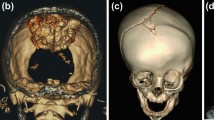Abstract
Neuroradiology is an essential tool in management of patients with neurological and neurosurgical disorders. The aim of this chapter will be to acquaint the reader to understand how images are formed on a computed tomography (CT) and magnetic resonance imaging (MRI) along with a review of the relevant neuroanatomy. This understanding will be helpful to the reader in interpretation of images and diagnosis of various neurological disorders.
Access this chapter
Tax calculation will be finalised at checkout
Purchases are for personal use only
Similar content being viewed by others
References
Allisy-Roberts PJ, Williams J. Farr’s physics for medical imaging. 2nd ed. Philadelphia: Saunders; 2007. p. 108–13.
Hacking C, Jones J. CT head (an approach). Radiopaedia. http://radiopaedia.org/articles/ct-head-an-approach. Accessed 25 Dec 2018.
Bell DJ, Greenwayl K. Hounsfield unit. https://radiopaedia.org/articles/hounsfield-unit. Accessed 25 Dec 2018.
Singh J, Daftary A. Iodinated contrast media and their adverse reactions. J Nucl Med Technol. 2008;36:69–74.
Lui YW, Tang ER, Allmendinger AM, Spektor V. Evaluation of CT perfusion in the setting of cerebral ischemia: patterns and pitfalls. Am J Neuroradiol. 2010;31:1552–63.
Xue Z, Antani S, Long LR, Demner-Fushman D, Thoma GR. Window classification of brain CT images in biomedical articles. AMIA Annu Symp Proc. 2012;2012:1023–9.
Gaillard F. https://radiopaedia.org/articles/orbitomeatal-line. Accessed 25 Dec 2018.
Osborne T, Tang C, Sabarwal K, et al. Part 1: basic principles of computed tomography and relevant neuroanatomy. http://www.southsudanmedicaljournal.com/archive/august-2016/how-to-interpret-an-unenhanced-ct-brain-scan.-part-1-basic-principles-of-computed-tomography-and-relevant-neuroanatomy.html. Accessed 25 Dec 2018.
Parizel PM, Makkat S, Van Miert E, Van Goethem JW, van den Hauwe L, De Schepper AM. Intracranial hemorrhage: principles of CT and MRI interpretation. Eur Radiol. 2001;11:1770–83.
Toyama Y, Kobayashi T, Nishiyama Y, Satoh K, Ohkawa M, Seki K. CT for acute stage of closed head injury. Radiat Med. 2005;23:309–16.
Rao MG, Singh D, Khandelwal N, Sharma SK. Dating of early subdural haematoma: a correlative clinico-radiological study. J Clin Diagn Res. 2016;10:HC01–5.
Chavhan GB, Shroff MM. Twenty classic signs in neuroradiology: a pictorial essay. Indian J Radiol Imaging. 2009;19:135–45.
El-Koussy M, Schroth G, Brekenfeld C, Arnold M. Imaging of acute ischemic stroke. Eur Neurol. 2014;72:309–16.
Beauchamp NJ Jr, Bryan RN. Acute cerebral ishemic infarction: a pathophysiologic review and radiologic perspective. AJR. 1998;171:73–84.
Truwit CL, Barkovich AJ, Gean-Marton A, Hibri N, Norman D. Loss of the insular ribbon: another early CT sign of acute middle cerebral artery infarction. Radiology. 1990;176:801–6.
Skalski M. CT head (an approach). Radiopaedia. https://radiopaedia.org/cases/brain-herniation-types. Accessed 25 Dec 2018.
Author information
Authors and Affiliations
Editor information
Editors and Affiliations
Multiple Choice Questions
Multiple Choice Questions
-
1.
Hounsfield units of pure water is:
-
(a)
0
-
(b)
−1000
-
(c)
+1000
-
(d)
+30
-
(a)
-
2.
CT features of epidural haematoma include:
-
(a)
Hyperdense image of collected blood
-
(b)
Biconvex opacity
-
(c)
does not cross suture lines
-
(d)
all the above
-
(a)
-
3.
Radiological feature of hydrocephalus in CT brain is:
-
(a)
Ventricles dilated but subarachnoid spaces effaced.
-
(b)
both ventricles and subarachnoid spaces dilated.
-
(c)
effacement of both ventricles and subarachnoid spaces.
-
(d)
none of the above.
-
(a)
-
4.
Pick out the correct statement:
-
(a)
An acute SDH is hyperdense to brain up to 1 week.
-
(b)
A subacute SDH may be isodense to brain in 1–3 weeks.
-
(c)
A chronic SDH may appear hypodense beyond 3–4 weeks.
-
(d)
All of the above.
-
(a)
-
5.
CT brain features of ischaemic stroke include:
-
(a)
Hyperdense vessel sign
-
(b)
loss of grey white matter differentiation.
-
(c)
Ex vacuo hydrocephalus.
-
(d)
All of the above.
-
(a)
Answers: 1. (a), 2. (d), 3. (a), 4. (d), 5. (d).
Rights and permissions
Copyright information
© 2020 The Editor(s) (if applicable) and The Author(s)
About this chapter
Cite this chapter
Ali, Z., Gupta, N. (2020). Basics of Neuroradiology. In: Bidkar, P., Vanamoorthy, P. (eds) Acute Neuro Care. Springer, Singapore. https://doi.org/10.1007/978-981-15-4071-4_6
Download citation
DOI: https://doi.org/10.1007/978-981-15-4071-4_6
Published:
Publisher Name: Springer, Singapore
Print ISBN: 978-981-15-4070-7
Online ISBN: 978-981-15-4071-4
eBook Packages: MedicineMedicine (R0)




